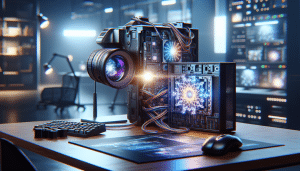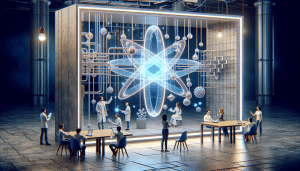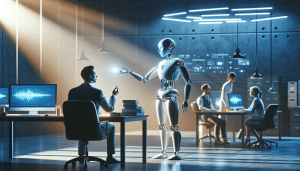AI Tools You Are Missing for Real Everyday Impact
Aiden Foster September 9, 2025
Artificial intelligence is changing how daily life, business, and science operate, yet many are unaware of the practical AI tools reshaping routines everywhere. This article explores how AI-driven solutions impact productivity, communication, and even creativity for real-world results.
Unlocking AI’s Practical Power: What Sets Today’s Tools Apart?
Artificial intelligence tools are increasingly embedded in tasks that once seemed routine but now benefit from advanced automation and analysis. Think about the routine use of AI-powered voice assistants, spam filters, and even personalized recommendations on streaming services. These systems are not just about novelty; they truly optimize everyday processes by learning from user behavior and continuously adapting to new patterns. What’s remarkable is how algorithms interpret huge datasets rapidly—analyzing thousands of emails to spot phishing, for example, or parsing handwritten notes into digital text with high accuracy. This ongoing integration marks a major shift, as basic operations become more efficient, secure, and tailored to individual needs through AI-enabled automation, machine learning, and speech recognition.
The surge in generative AI goes further, enabling creative collaboration in areas like visual design, content writing, and even music composition. Generative AI models can suggest outlines, automate repetitive graphic tasks, or simulate complex scenarios for scientific research. It’s not just organizations that gain from these breakthroughs—AI-driven personal finance apps, fitness trackers using predictive analytics, and language translation platforms all build convenience and efficiency into users’ daily lives. As experimentation grows, so does the toolkit available to solve ever-wider sets of problems.
Much of this progress is possible thanks to accessible platforms supported by open-source development and global research collaborations. When individuals and small firms can implement ready-made AI models or train specialized ones, the barrier to entry falls drastically. Initiatives around digital literacy and AI upskilling, often offered by leading tech companies or nonprofit partners, also make these tools approachable for broader audiences (see: https://www.coursera.org/learn/ai-for-everyone). The practical power of AI is now in the hands of millions—and its reach keeps widening.
The Workplace Revolution: AI Solves Problems Fast
Enterprises across industries discover daily that AI platforms—especially those using machine learning and natural language processing—can accelerate complex projects and ease labor-intensive tasks. Automated customer service chatbots, for example, now provide round-the-clock support, freeing up human teams for higher-value work. Document management platforms can scan, interpret, and store vast numbers of files using intelligent recognition algorithms. By reducing both errors and manual effort, AI-driven solutions enhance productivity and accuracy for entire organizations.
Managers and employees now use AI-powered data analytics tools for forecasting sales, optimizing logistics, and tracking key performance indicators. Predictive analytics reveal patterns in large datasets, offering insight that leads to better decisions. Hiring processes also gain from AI: automated resume-screening platforms fairly match candidates’ qualifications to job requirements, reducing bias and improving efficiency. It’s not about replacing people; it’s about amplifying teams with smart assistance that untangles complex projects and makes hidden opportunities visible. As research from the National Institute of Standards and Technology highlights, AI-driven analysis can improve logistical planning and project management across sectors (https://www.nist.gov/artificial-intelligence).
Remote and hybrid workforces especially benefit from these innovations. AI scheduling assistants, transcription tools, virtual meeting platforms with live translation, and smart project dashboards all reflect how automation now works quietly in the background. By weaving AI into everyday workflows, organizations improve not just efficiency but collaboration and inclusivity. The workplace revolution is already here, subtly changing what gets accomplished each day—and how.
AI and Personal Productivity: From Planning to Learning
The surge of artificial intelligence in personal productivity tools has opened new ways for individuals to organize, plan, and execute tasks. AI-powered note-taking apps automatically summarize meetings, highlight action items, and sync across devices, making information retrieval as seamless as possible. Virtual tutors using natural language processing adapt study plans to each learner’s pace, providing feedback that used to require a private instructor. These applications promote self-improvement and lifelong learning, especially for users managing demanding schedules.
For many, language translation tools now offer near real-time conversion of conversations—making global communication easier and eliminating many historical barriers. AI-powered calendar and time management assistants automatically suggest optimal meeting times, anticipate travel delays, and flag overlapping commitments. These subtle adjustments help people prioritize with less stress. Many personal finance and budgeting apps use machine learning to analyze spending habits and suggest savings techniques, a function that was previously the exclusive domain of financial advisors (https://www.consumerfinance.gov/about-us/blog/how-artificial-intelligence-is-changing-financial-services/).
As AI becomes more intuitive, the boundary between human intuition and algorithmic prediction continues to blur. Smart reminders, automated checklist apps, and adaptive to-do lists all reflect an ongoing trend: AI is reimagining traditional productivity paradigms. Individuals no longer have to actively monitor every task—algorithms can track, prompt, and even automate, making time for truly meaningful work or restorative breaks. AI-driven productivity isn’t just about speed; it’s about working smarter, not harder.
Transforming Creativity and Communication with AI
AI’s impact on creative pursuits is evident across fields such as writing, visual arts, music, and filmmaking. Content creators use AI-powered brainstorming platforms to overcome writer’s block or generate unique concepts. Visual designers leverage AI tools to create custom imagery, explore alternative color palettes, or simulate atmosphere, adding diversity to their work in minutes rather than hours. The creative process expands as these systems deliver endless variation and instant feedback.
Digital communication also transforms with AI-driven chatbots, real-time translation, and smart autocorrect features embedded in messaging apps. These subtle enhancements ensure that messages reach their audience clearly, regardless of native language or writing proficiency. In the world of marketing, AI-driven personalization crafts targeted campaigns by analyzing data from millions of interactions—resulting in advertising that feels more relevant and engaging for every recipient (https://www.ama.org/marketing-news/why-ai-is-the-future-of-marketing/).
AI is increasingly supporting the democratization of creativity, making sophisticated design, video editing, and storytelling tools accessible to non-experts. For students, researchers, and hobbyists alike, intuitive interfaces lower the skill barrier, unlocking possibilities for digital creativity once limited to professionals. The AI-assisted creative revolution is about empowering more voices, reducing friction, and expanding what’s possible in every medium.
AI and Ethical Considerations: Building Trust in Smart Systems
With powerful AI tools now commonplace, questions about privacy, transparency, and ethical use are front and center. Responsible developers must implement bias monitoring, explainable logic, and clear consent for data usage. The European Commission and international standards bodies work to promote frameworks that prioritize personal agency as AI becomes increasingly autonomous (https://digital-strategy.ec.europa.eu/en/policies/european-approach-artificial-intelligence).
Users also play a crucial role. By selecting tools that offer privacy controls, clear data handling policies, and transparent reporting, individuals influence how the industry evolves. Many companies provide transparency reports and include built-in explainability—showing why algorithms made certain decisions—to foster trust and user confidence. Trusted AI should always offer an opt-out or allow review of personal data being used by the system. Independent oversight is also expanding as organizations like the AI Ethics Lab collaborate with researchers worldwide.
The future of AI will hinge on responsible use and informed participation. Learning how AI systems work, their benefits, and their limits enables smarter adoption. Developers and users alike must demand ethical, reliable systems. As new policies and guidelines roll out across governments and industry, a balance between innovation and responsibility is emerging—one with the public’s interests at its heart. Ultimately, trust is the foundation of any smart society.
What’s Ahead for AI Tools in Everyday Life?
With exponential advances in computing and data science, the landscape for AI-powered tools will continue to grow. The next generation could include devices that anticipate user needs without explicit instruction, or platforms that collaborate across networks to solve problems collectively. Smart home systems, wearable health monitors, and autonomous mobility solutions may soon become standard features in daily routines.
The influence on education, healthcare, and even civic engagement will also expand. Personalized medicine, for instance, leverages AI to tailor treatments and monitor patient progress, while city governments use predictive analytics to improve traffic systems and emergency responses. The key is to foster open dialogue, ongoing innovation, and widespread access to new technology so its benefits are equitably distributed (https://ai.nih.gov/research/ai-healthcare).
AI tools are no longer a glimpse of the future—they are already integrated into the fabric of modern life. Staying curious, informed, and engaged with their evolution ensures individuals, organizations, and societies get the most from what’s possible, while also addressing important questions about fairness, safety, and access. The story is far from finished; with each development, new chapters are written in the partnership between human intelligence and artificial minds.
References
1. Ng, A. (n.d.). AI For Everyone. Retrieved from https://www.coursera.org/learn/ai-for-everyone
2. National Institute of Standards and Technology. (n.d.). Artificial Intelligence. Retrieved from https://www.nist.gov/artificial-intelligence
3. Consumer Financial Protection Bureau. (2021). How artificial intelligence is changing financial services. Retrieved from https://www.consumerfinance.gov/about-us/blog/how-artificial-intelligence-is-changing-financial-services/
4. American Marketing Association. (2021). Why AI is the future of marketing. Retrieved from https://www.ama.org/marketing-news/why-ai-is-the-future-of-marketing/
5. European Commission. (n.d.). European Approach to Artificial Intelligence. Retrieved from https://digital-strategy.ec.europa.eu/en/policies/european-approach-artificial-intelligence
6. National Institutes of Health. (n.d.). AI and Healthcare. Retrieved from https://ai.nih.gov/research/ai-healthcare








